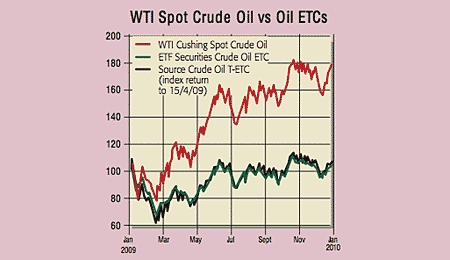
Commodity trackers are the most complex type of exchange-traded product. That’s a bad thing. Complexity always favours the product issuer and works against an uninformed investor. So if you’re thinking of using them, you need to do your homework.
Take oil trackers. If you’d predicted a rebound in the price of crude oil from its 2009 low of $31 a barrel, you’d have been spot on. But if you’d bet on it using an oil exchange-traded commodity (ETC), your return would have fallen far short of the oil price’s gain because of ‘contango’.
Most ETCs track the underlying asset price using futures contracts. When a contract expires, the tracker buys (or ‘rolls over’) into a longer-dated one. When a market is in contango, it means that the further into the future you go, the higher the price of the relevant contract. So when you swap the expiring shorter-dated contract for a longer-dated one, you incur a cost. This can be very high indeed. The spot oil price went up 78% last year, but ETF Securities’ and Source’s Crude Oil ETCs gave only single-figure returns (see chart).
It doesn’t always work this way. Backwardation, the opposite to contango, boosted tracker performance during most of the 1990s. But the point is that the futures curve can be far more important to a tracker than the spot price – so if you want to bet on commodities using ETCs, you need to take account of this.
There is one area of the commodities market where contango effects are minimal – physically backed precious-metals trackers, such as ETF Securities’ ETCs which track physical gold, silver, platinum and palladium. So we’d be happy to play the price of gold, for example, with a tracker.
But if you plan to invest in the wider commodities markets, we’d suggest an ETF that aims to minimise the negative impact of contango (and maximise the backwardation benefits): db x-trackers’ DBLCI-OY Balanced fund (LSE: XBDB).
The fund does this by choosing futures contracts from along the curve, rather than automatically rolling into the next contract month. It reflects the performance of 14 commodities. It has a 55% weighting in energy, 10% in precious metals, 13% in industrial metals, and the remainder in corn, wheat, soybeans and sugar. The fund is Europe’s largest diversified raw materials ETF and has a total expense ratio of 0.55% a year.
• Paul Amery is editor of
www.indexuniverse.eu .